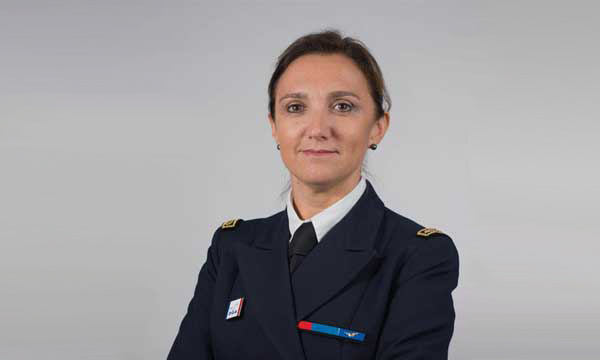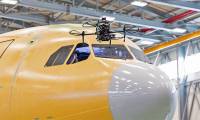For the DGA, « the future is a real network of sensors » |
| Helen Chachaty |
|
|
24 MAR 2017 | 1444 words
|
 |
© DGA |
|
|
|
Strategy Manager of the Directorate General of Armaments since December 2014, Caroline Laurent is also the second woman to reach the rank of ingénieure générale hors classe de l'armement (first-class Engineer General for Armament), after Monique Legrand-Larroche, Operations Manager at the DGA and also a four-star general officer.
At the command of the Strategic Manager, Caroline Laurent is piloting the mission to prepare one of the DGA's three missions for the future, which also involves equipping the forces and supporting exports. With a focus on R&D, Defence Technological and Industrial Base (EDTIB) and SME support, the DGA's strategic dimension also allows for the maintenance of critical and key activities, as well as the preparation of the initial stages of armament programmes.
Why is it important to maintain a high degree of innovation?
Innovation is necessary to prepare the future, and even more so right now. We are facing a threat that is continually evolving, countries that were no longer a threat and are becoming so once more and a whole technological environment, capabilities coming from the civilian world that are light-weight and inexpensive, accessible to everyone and that are starting to become a real threat, especially for weapon systems. Innovation is becoming accessible to everyone and so we need to be innovative in order to maintain technological superiority. This technological superiority is not just to have the fastest jet or the strategic missile that no-one else has, but also to be better in terms of innovation. To be one step ahead also means being one step ahead in new technologies, in new uses, with the integration of innovations coming from the business world. This is even more essential now than in the past with the proliferation of threats that are easy to access and are low-cost.
What are the DGA's main approaches to military aeronautics?
We have two major approaches towards transformation in the domain of military aeronautics: digitization and networking. The threat has arisen from sensor fusion, so we must do the same where weapon systems are concerned. Today, aircraft mostly operate by themselves and they have adequate specifications. Until now, pilots essentially reported to the ground. In the future, there will no longer be a lone aircraft; planes will fly in a patrol, with intelligence or combat drones.
The future is a real network of sensors. We can imagine that a drone will detect the target, a missile will be launched by the aircraft, the location will be provided by means of sensor fusion among several platforms, all linked by a high-speed communication network. Entire patrols that fuse their data, with the mass use of artificial intelligence, are the future. This is a huge transformation in the future of combat aeronautics. The United States is already implementing this type of highly secured links between platforms. We are carrying out quite advanced research on the networking of sensor on combat planes because this is what poses the greatest challenge.
What about innovation domains?
Generally speaking, there are two areas of innovation in aeronautics: stealth and speed. In general we can't be stealthier and faster at the same time. Should the drone be faster to get there before the fighter jet, or should it be capable of not being noticed early on ? The UCAV should be based on stealth, so that it can see the opponent's defences and warn the planes that are following behind, or destroy the defences. In a system of global combat, speed is in the missile, stealth is in the drone. So it's a question of implementing human-computer interfaces, algorithms to know who will make the decision on what action. The DGA is also working on drone tests with a certain number of laboratories. All of this is linked to artificial intelligence and the sharing and fusing of data.
Within the sphere of helicopters and transport aviation, we're working on the integration of civil technologies, how to make them cheaper, less specific, with smaller and higher-performance sensors. We're interested in materials and energy consumption, but less so than in the civilian world, even if we should be concerned about the environment. It's not necessarily a case of using less, but rather of making the same thing go further, which is not so much about going further but rather about starting as far ahead as possible.
Does European cooperation make any sense in the area of Defence innovation?
In the missile domain, with the example of One MBDA, it is fairly innovative to say that, for a system as supreme as that of cruise missiles, we consent to having a manufacturer with certain areas of expertise in the United Kingdom. Although we prefer the areas of expertise linked to self-guidance to remain in France for the time being, for example, we do however consent to outsourcing some of these areas to the United Kingdom. There is a certain number of fairly solid intergovernmental agreements between the two countries, which lay the cards on the table particularly in matters concerning export licences and authorisations, as if there were only a single country involved in these matters. This creates quite a strong bond with the British, strong enough to say that, with or without Brexit, it will still be done. It's the beginning of what will one day be the European industry.
So are we heading towards bilateral more than multilateral cooperation?
It can be done in several countries, but it's easier to start with just two and add other nations later on. We must be at the same level technologically, with neither feeling nor being superior to the other.
What is the DGA's strategy for supporting innovation with large groups and SMEs simultaneously?
As our systems respond to long-term developments and long cycles, we are of course working with large groups, because a certain industrialisation capacities, as well as financial and industrial durability, are needed. We also have several tools for accompanying and supporting SMEs with the Defence-SME pact or the RAPID programme for subsidising innovative and dual-purpose SMEs.
Under RAPID, we have 50 million Euro a year to finance about 60 projects. We'd like these innovations to be dual-purpose because we finance a prototype and then a development, we increase the maturity but we know that it won't become an object in the field very quickly and so we want to be sure that the innovating SME knows how to stay afloat in the long-term. Therefore, we request that the innovation be dual-purpose so that it can also be sold in the civilian world. This is the example of Delair, which also market drones to civilian enterprises. This reasoning also applies to large groups.
How can innovation enter the field faster?
We have a line of work in the transformation plan "DGA 2025 Immediate Anticipation", which deals precisely with that question. How can an SME that has had a good idea test its innovation at a technical or military test centre?
We don't tend to carry out experiments until we're sure we're going to buy. We've found a way of financing laboratories and SMEs, but to go from one to the other it is necessary to do the tests more quickly, perhaps even before knowing if they're necessary. We need to find out how to gain more demonstrators before demonstrating the technological feasibility, to test the usage before knowing if we know how to do it, to rule out the option, where appropriate.
What about the MIP and the DGA Lab?
The participative innovation mission (French acronym MIP), is a member of the military or the DGA who develops something in their own workshop, using their field experience. The best example is Auxylium, the smartphone information system, which was used during the parade on July 14th and the Euro 2016 and is particularly adapted to Sentinelle. One day, someone thought, "Why not adapt the system I have on my smartphone to other uses?" We can also cite the non-slip coating used to make deck-landing safe, or the BLU-111 protection layer (to adapt the SEM bomb casing to the Rafale Marine, NDLR).
Regarding the DGA Lab, this was created through the logic of accelerating the transition between innovation and use. For the time being, the SMEs approach us to present their projects and we look to see what might be of interest, a contract, a RAPID grant... The idea is that, by creating an innovation laboratory, we have a point of contact between the innovators and the users, an innovation incubator under the DGA Lab label. |
|
| |
| |
|
|
Top stories |
|
21 JUN 2019
 Drone maintenance for the A400M
Drone maintenance for the A400M
Airbus Defence & Space's latest ambition is to develop its drone maintenance capabilities. The European aircraft manufacturer has signed a cooperation agreement with the Spanish ... Continue Reading
|
|
|
|
|
|
|
Top stories
|